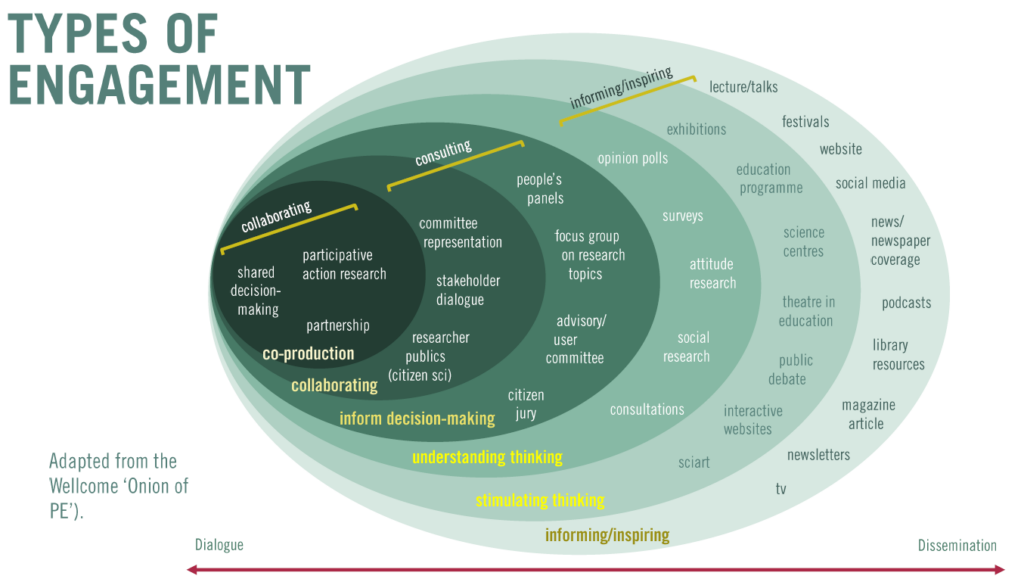Briefly analysed
Public engagement means: science and citizens are in an exchange. So are those responsible within the field. This helps to advance science. In addition, citizens not only gain a better understanding of science, but their questions and ideas are also heard. Public engagement is therefore more than just the communication of knowledge. It is an exchange that takes place. Unfortunately, science in Germany does not sufficiently realise this potential. Many do not understand the principles of public engagement. Ultimately, therefore, a cultural change is needed.
Understanding There is a lot of potential in public engagement. For this, it is necessary to first understand this approach. Our perspective about what constitutes a basic understanding of public engagement.
Public engagement is still not very widespread in the university landscape in Germany, because there is a lack of a fundamental understanding of public engagement. This understanding is important to establish public engagement (PE). What constitutes a fundamental understanding of public engagement? And why is it currently more important to properly understand the potential of public engagement – more important than just knowing participatory formats. The following sections provide an answer.
Public Engagement is exchange and collaboration
We understand public engagement as an approach based on collaboration, exchange and dialogue. This all takes place both with the public and among the people working in the field. For example, the directors of institutions, funding partners, stakeholders, researchers and communication professionals.
In addition to professionals also researchers interact with the public. If they only communicate their research, it is called science communication. This involves the exclusive communication of research, for example on social media, through podcasts or lectures. There is little dialogue with the public. Dialogue here is rather understood to mean that the public has the opportunity to ask questions about the content of this communication.
SciComm is part of Public Engagement
In our view, the usual science communication is a part of PE: with a lot of monodirectional communication of content and little “engagement” with the public. The figure “Types of Engagement” clearly shows the outlined structure of PE.

Source: Berlin School of Public Engagement and Open Science, adapted from the Wellcome “Onion of PE”
Deficits in communication
Currently, the “deficit model” is the standard in science communication in Germany. Even though there are many attempts to improve comprehensibility and clarity in communicating research to the public, the approach remains the same: there are knowledge deficits. In addition, interactions and a dialogue with the public rarely take place, even though this is repeatedly stated as a goal. But for good research, it is important that those affected by research topics interact with scientists. This allows them to express their views or issues, which are also useful to the researchers.
Public Engagement serves the common good AND research
It is often the case that researchers operate exclusively in their scientific bubble. They thus overlook the problems, issues or even solutions that stakeholders from society have in the respective research area. Public engagement – especially dialogue and exchange – can counteract this deficit. The public benefits from that, because science does more likely take the public concerns into account in research. Research thus becomes society-oriented. Likewise, research benefits from this exchange and input.
In general, public engagement serves the common good AND research. Public engagement is both value and democracy oriented. Therefore, it is imperative that practitioners address the breadth of society. Because: Most of the time, the usual formats of science communication only reach people who are interested in science anyway. But people with less affinity for science, underrepresented or marginalised groups also benefit from public engagement. Not only because engagement with them is helpful for a functioning democracy. But also because communication and exchange with people with less affinity to science open up new perspectives for one’s own research.
Directors need PE understanding
Everyone involved in science and research should be aware of these advantages of public engagement. Not only those for society, but also that it brings benefits for the institution. Public engagement can enhance the reputation of an institution. Researchers who are in contact with society are in the public eye. They can gain attention through their engagement and make research better.
Directors should understand this as well. So that they value, challenge and motivate PE. According to the NCCPE, “PEPs – in common with many other professional services staff – are often in marginal roles and their contribution is often not clearly valued or understood. (NCCPE, 14) Only through understanding practitioners develop an optimal strategy for both the institutions and the PE project and know which formats are suitable.
Sustainable engagement through continuous dialogue
Ultimately, Germany needs a cultural change – a change of mindset: public engagement is the comprehensive field, the “umbrella term”, which also includes traditional science communication. But apart from communication, it is about much more: dialogue and exchange, which practitioners should continuously maintain. Because only then a sustainable commitment will be established.
NOTE
The code initiated by the Berlin School of Public Engagement and Open Science is helpful for a basic understanding. Interested parties are currently developing it. Everyone is invited to join in and contribute their ideas.
